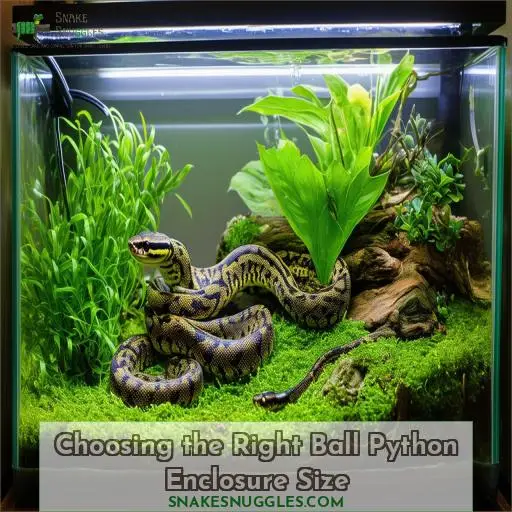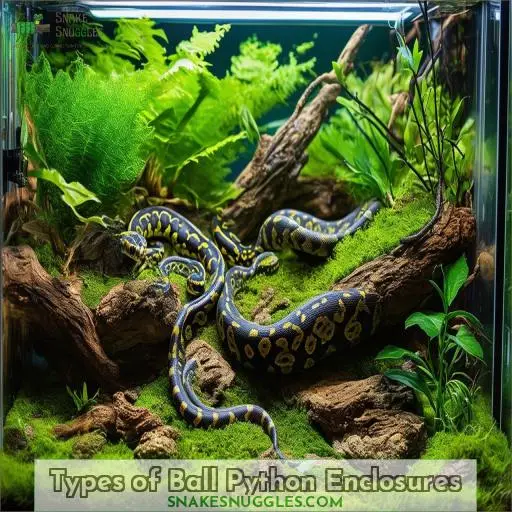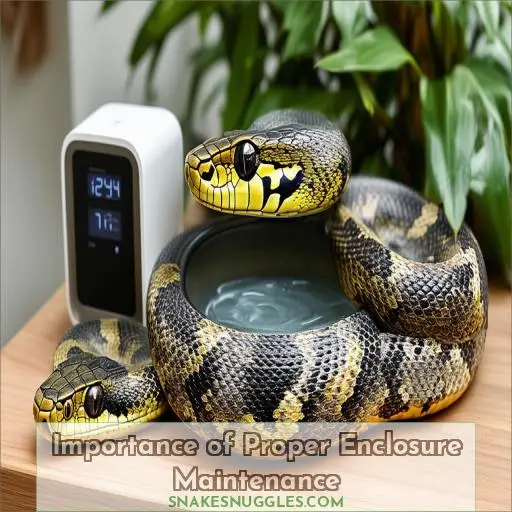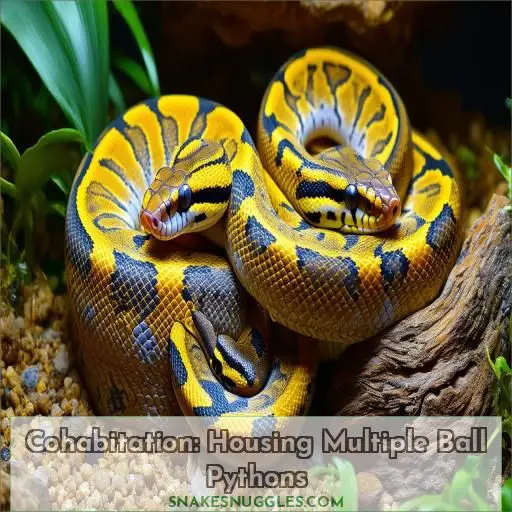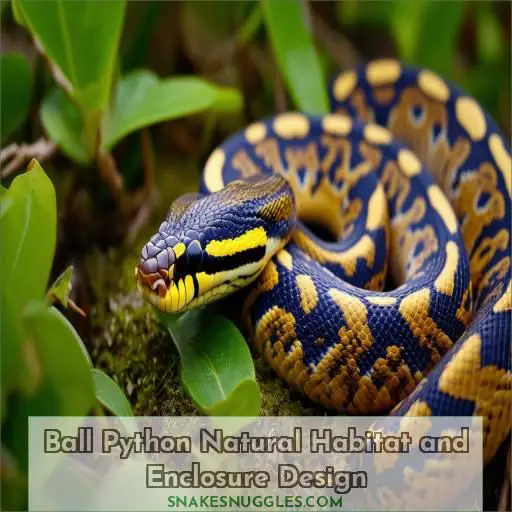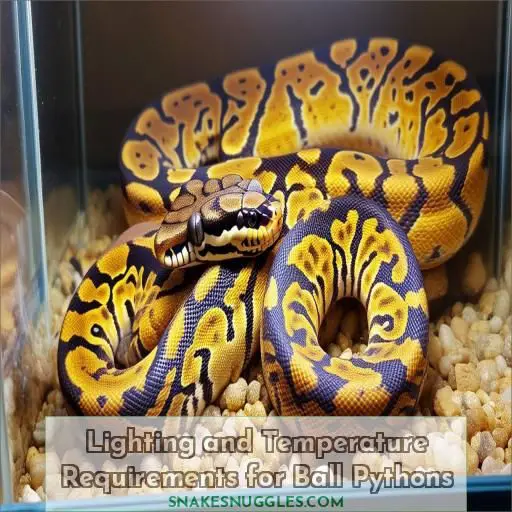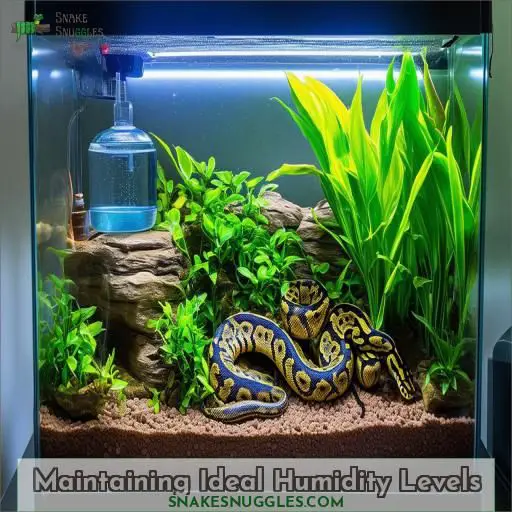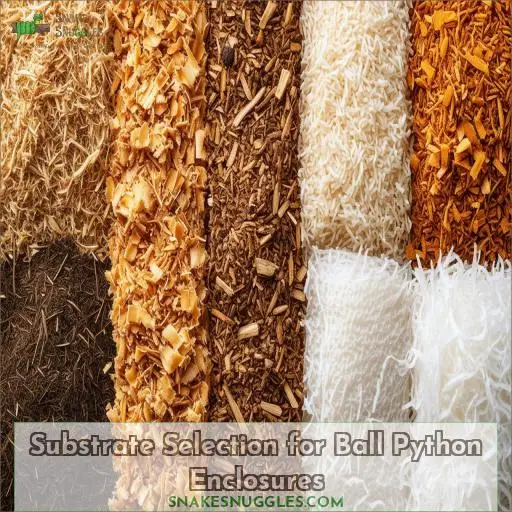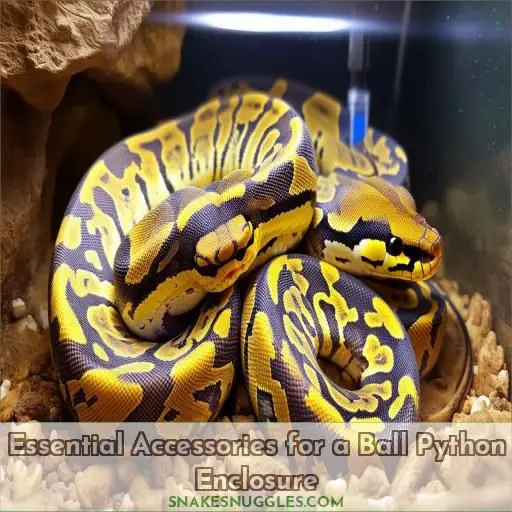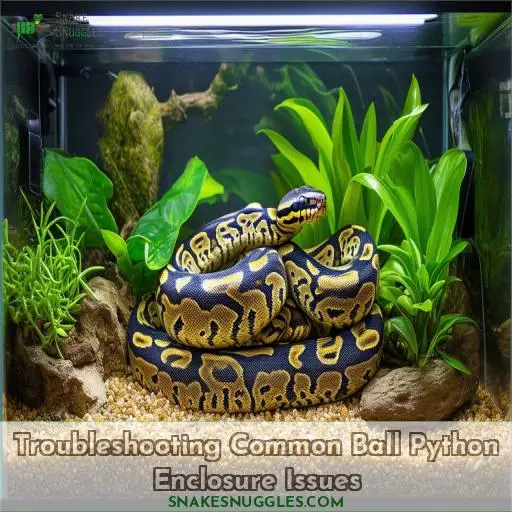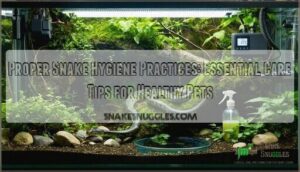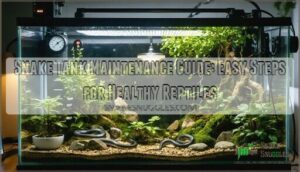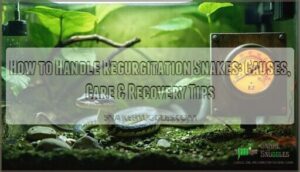This site is supported by our readers. We may earn a commission, at no cost to you, if you purchase through links.
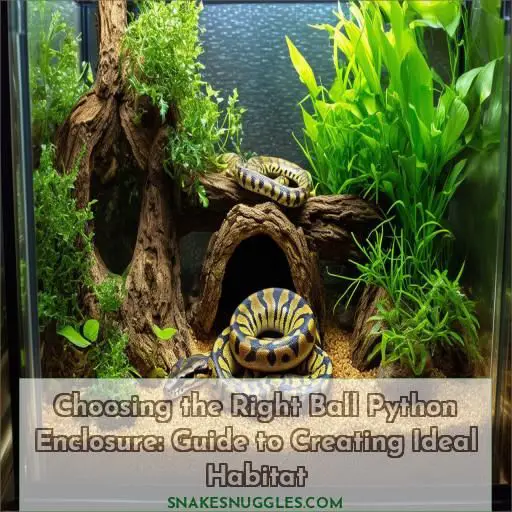 Choosing the correct ball python enclosure is essential for their health. First, select an appropriately sized enclosure with ample floor space and height for climbing.
Choosing the correct ball python enclosure is essential for their health. First, select an appropriately sized enclosure with ample floor space and height for climbing.
Glass aquariums, commercial cages, plastic tubs, or custom-built options each offer unique advantages. Prioritize proper ventilation, front-opening doors for easy access, and a substrate layer deep enough for burrowing.
Implement a daily spot-cleaning routine and conduct deep cleanings monthly, replacing the substrate every few months. Maintain ideal humidity levels between 50-60% and create a temperature gradient to mimic their natural habitat.
Dialing in these key factors will guarantee a thriving environment for your ball python, but the specifics deserve a closer look.
Table Of Contents
- Key Takeaways
- Choosing the Right Ball Python Enclosure Size
- Types of Ball Python Enclosures
- Importance of Proper Enclosure Maintenance
- Cohabitation: Housing Multiple Ball Pythons
- Ball Python Natural Habitat and Enclosure Design
- Lighting and Temperature Requirements for Ball Pythons
- Maintaining Ideal Humidity Levels
- Substrate Selection for Ball Python Enclosures
- Essential Accessories for a Ball Python Enclosure
- Troubleshooting Common Ball Python Enclosure Issues
- Frequently Asked Questions (FAQs)
- What type of enclosure is best for a ball python?
- What kind of habitat do ball pythons prefer?
- Can a cage be too big for a ball python?
- Is a 75 gallon tank good for a ball python?
- How often should I replace the water in my ball pythons dish?
- Can I use a heat lamp to provide both heat and UVB lighting?
- Is it safe to house a male and female ball python together?
- How do I know if my ball python is getting enough exercise?
- What should I do if my ball python refuses to eat in its new enclosure?
- Conclusion
Key Takeaways
- Selecting the right enclosure is like finding that cozy reading nook – it’s all about creating a space your ball python can call home sweet habitat. Whether it’s a sleek glass aquarium or a sturdy PVC palace, the key is nailing that Goldilocks zone of not too big, not too small, just right.
- Maintaining that optimal humidity sweet spot is crucial – think of it as your python’s personal rainforest retreat. An absorbent substrate like coconut fiber helps lock in that tropical vibe, and a well-placed water dish adds the perfect splash of moisture to keep your scaly pal happy as a clam.
- Accessorize, accessorize, accessorize! Your python’s humble abode needs all the trimmings – from cozy hide boxes for nap time to climbing branches for a little vertical exploration. It’s like an all-inclusive resort, but for a snake who prefers room service over the buffet.
- Don’t be a helicopter parent – give your python some space! Cohabitation is a big no-no in the snake world, kind of like forcing your teenage kids to share a twin bed. Each python deserves their own private oasis to stretch out, bask, and avoid any potential slither-sibling squabbles.
Choosing the Right Ball Python Enclosure Size
When selecting the appropriate ball python enclosure size, you’ll need to contemplate the ideal space dimensions based on the snake’s age and length. Various enclosure types such as glass aquariums, commercial cages, or custom-built options should be evaluated, taking into account factors such as maintenance frequency and suitability for the species’ needs.
Optimal Space Dimensions
When choosing the ideal ball python enclosure size, consider these key factors:
- Footprint dimensions should allow your snake to fully stretch out and explore comfortably .
- Grant proper ventilation systems for air circulation and temperature regulation (Source).
- Front-opening doors provide easy access while maintaining security features .
Provide a substrate depth of at least 2-3 inches for burrowing and natural behaviors . With these guidelines, you can create a safe, spacious habitat customized to your ball python’s needs.
Enclosure Type Comparisons
When choosing a ball python enclosure, consider materials like glass or PVC. Glass provides visibility and heat dissipation, while PVC is lightweight, durable, and holds humidity well. Guarantee proper ventilation, aesthetics, and security features. Utilize space efficiently with hides, branches, and substrate. Glass and PVC enclosures offer the best options for maintaining ideal humidity levels for your ball python.
Maintenance Frequency
Maintaining your ball python enclosure is essential for its health. Guarantee substrate maintenance by spot cleaning daily, removing waste promptly. Check humidity levels twice a day to keep them within the desired range. Follow this cleaning schedule for best care:
- Daily Spot Cleaning: Remove waste and contaminated substrate.
- Monthly Deep Cleaning: Clean all enclosure components.
- Substrate Replacement: Every 3-4 months.
Types of Ball Python Enclosures
When choosing an enclosure for your ball python, you have several options available, including glass aquariums, commercially manufactured cages, plastic storage boxes, and custom-built enclosures.
Write a 100-word (maximum) description of the ideal ball python habitat, including information about size, temperature, humidity, and shelter.
The ideal ball python habitat features a spacious enclosure, ranging from a 20-gallon tank for juveniles to a 40+ gallon for adults. Select a glass or plastic container with a well-ventilated, secure lid. Fill it with a suitable substrate, such as aspen shavings or coconut husk, and add two hide boxes, one on each end, for privacy. Decorate with artificial plants and other cover. Create a thermal gradient with a basking area of 88-96°F (31-36°C) and a cooler side of 78-80°F (25-27°C). Maintain humidity levels between 60-80% for proper shedding
. Each option offers distinct advantages and considerations, such as visibility, ease of cleaning, humidity regulation, and overall suitability for your snake’s size and needs.
Glass Aquariums
Glass aquariums are an affordable option for housing baby ball pythons, offering excellent visibility.
However, they can be fragile and struggle to retain heat effectively.
Guarantee proper ventilation by covering three walls with opaque material for security.
Use a substrate depth of 2-3 inches.
Consider adding non-toxic plants for enrichment.
Monitor temperatures closely.
Maintain humidity levels between 50-60% for ideal health.
Commercially Manufactured Cages
Commercially manufactured cages offer a convenient and durable option for housing your ball python.
Vision Cages, for example, feature front-opening designs for easy access and are specifically engineered for proper heating and ventilation.
The Model 211 is ideal for baby snakes.
The Model 332 and 433 provide ample space for adult ball pythons.
These cages prioritize aesthetics, accessibility, and safety in their design, making them a popular choice among ball python enthusiasts.
Plastic Storage Boxes
Plastic storage boxes offer an affordable and lightweight option for ball python enclosures. Look for designs with:
- Adequate ventilation holes to maintain proper airflow and humidity levels
- Smooth, non-porous surfaces that are easy to clean and disinfect
- Secure locking lids to prevent escape and guarantee your snake’s safety
- Sufficient size to accommodate your ball python’s growth and allow for natural behaviors
While plastic tubs are budget-friendly, consider potential drawbacks like limited visibility and potential durability concerns over time . Prioritize your snake’s well-being when selecting the right enclosure for their long-term health and happiness.
Custom-Built Enclosures
Custom-built enclosures offer unparalleled flexibility, allowing you to tailor the design to your ball python’s unique needs. Prioritize proper ventilation, durability, and aesthetics when constructing the enclosure. Seal wood with non-toxic sealants, and make certain the enclosure is escape-proof. With careful planning, a custom-built enclosure can provide the ideal habitat for your ball python.
| Feature | Importance | Considerations |
|---|---|---|
| Ventilation | High | Adequate airflow to prevent stagnation |
| Durability | High | Withstand wear and tear, secure latch |
| Aesthetics | Medium | Complement your decor, showcase your snake |
| Customization | High | Tailor to your snake’s size and needs |
| Cost | Low | Materials and tools required |
Importance of Proper Enclosure Maintenance
Now that you’ve carefully selected the perfect enclosure for your ball python, it’s imperative to maintain it regularly to keep your snake happy and healthy.
Spot-clean the habitat after each bowel movement to remove waste and soiled substrate .
Replace the substrate entirely every 3-4 months to prevent odors and bacterial buildup .
Perform a deep clean twice yearly using a disinfectant like F10SC or a 10% bleach solution . This kills any lingering germs and parasites.
Wipe down all surfaces and accessories, rinse thoroughly, and allow to fully dry before reassembling .
Proper waste management and enclosure sanitation are key to avoiding disease and parasite infestations in your ball python .
Cohabitation: Housing Multiple Ball Pythons
While it may seem like a good idea to house multiple ball pythons together, cohabitation isn’t recommended and can lead to serious health issues and even death.
Ball pythons are solitary animals that require their own space to thrive. Sharing an enclosure can cause severe stress, aggression, and competition for resources like food and hiding spots . Cannibalism has been documented in cases of cohabitation .
If you have multiple ball pythons, it’s imperative to provide each snake with its own enclosure that meets its species-specific needs . Proper handling and minimizing interactions between snakes is also essential for their well-being .
Prioritize your ball pythons’ safety and comfort by housing them separately.
Ball Python Natural Habitat and Enclosure Design
When designing a ball python enclosure, it’s important to recreate their natural habitat as closely as possible. These snakes thrive in a tropical environment with a mix of ground cover and climbing surfaces. To achieve this:
- Provide a temperature gradient with a warm side (80-85°F) and a cooler side (75-80°F) to allow your python to thermoregulate.
- Include plenty of hiding spots, such as caves and hollow logs, to make your snake feel secure. Distribute these hides evenly across the warm and cool ends.
- Incorporate branches, vines, and other structures that allow your python to climb and explore its surroundings. This enrichment keeps your snake active and engaged.
- Use a substrate that retains moisture well, such as coconut fiber or cypress mulch, to maintain the ideal humidity level of 60-70%. Mist the enclosure regularly to prevent it from drying out.
Lighting and Temperature Requirements for Ball Pythons
You’ll need to provide the proper basking spot temperatures for your ball python, typically between 88-92°F. Additionally, maintain an ambient temperature gradient within the enclosure, with the cool side in the mid-70s°F and the warm side around 80-85°F by using overhead heating elements and following an appropriate lighting schedule.
Basking Spot Temperature
A precise basking spot temperature is important for your ball python. Aim for 87-92°F using suitable heat sources such as lamps or radiant heat panels. Proper cage placement and materials help maintain consistent warmth. Make sure floor covering isn’t flammable and choose safe plants, enhancing the aesthetic. Position thermometers to verify accuracy .
Ambient Temperature
To maintain ideal ambient temperatures, keep the warm side between 80-85°F and the cool side at 75-80°F. Use a humidity gauge to monitor density. Provide elevated surfaces like branches for climbing and relaxation. Offer food and water bowls in appropriate sizes. Substrate like coconut fiber helps retain moisture for proper humidity levels.
Lighting Schedule
Ball pythons thrive on a consistent 12-hour daylight cycle. Use a timer to automatically turn on UVB lighting at dawn and off at dusk. Avoid night lights, as they can disrupt the snake’s natural circadian rhythms. Gradually dim the lights over 30 minutes to mimic sunset. Maintain this schedule year-round for optimal health and behavior.
Maintaining Ideal Humidity Levels
Now that you have the perfect enclosure with the ideal temperature gradient, it’s time to tackle humidity. Ball pythons thrive in a humid environment, with a relative humidity of 50-60%. To maintain this, use a hygrometer to monitor levels and mist the enclosure 1-2 times daily if needed. Opt for an absorbent substrate like coconut fiber that retains moisture well. Provide a large water dish, but make certain it’s not so deep that your snake could potentially drown. Keep the enclosure clean by spot-cleaning waste and changing the substrate regularly. With a little diligence, you’ll create the perfect humid hideaway for your ball python to thrive.
- Use a hygrometer to monitor humidity levels and mist enclosure as needed to maintain 50-60% humidity.
- Choose an absorbent substrate like coconut fiber that retains moisture well to help maintain humidity.
- Provide a large water dish, but make certain it’s not so deep that your snake could potentially drown.
Substrate Selection for Ball Python Enclosures
When selecting a substrate for your ball python’s enclosure, opt for an absorbent material like coconut fiber or cypress mulch to help maintain ideal humidity levels. Avoid fine particulate substrates like sand or calcium-based products, as these can pose an ingestion risk and fail to hold moisture effectively.
Discussion Points
When selecting a substrate for your ball python’s enclosure, prioritize materials that promote humidity retention and prevent ingestion risks. Front-opening enclosures with secure lids enhance accessibility and safety. Provide ample cover and hiding places, as python security is essential. Regular spot cleaning helps maintain hygiene and reduces the potential for health issues .
Absorbent Substrates Maintain Humidity [2
Choosing an absorbent substrate is key for maintaining ideal humidity levels in your ball python’s enclosure (Source). Look for substrates like coconut fiber or cypress mulch that can hold moisture well . Aim for a substrate depth of 2-4 inches to allow burrowing and humidity regulation . Most ball pythons prefer a substrate that feels natural underfoot .
Avoid Fine Particulates Ingestion Risk [2
When selecting a substrate for your ball python’s enclosure, avoid fine particulates like sand or small wood shavings. These can be accidentally ingested while your snake is hunting, leading to intestinal blockages or impaction .
Instead, opt for a moisture-retentive substrate like coconut fiber to maintain ideal humidity levels .
Provide ample hiding spots and climbing branches to create a secure, enriching environment for your pet .
Spot Clean Regularly Prevent Odors [2
To keep odors at bay and maintain humidity, regular spot cleaning is essential. After choosing substrate options, follow these steps:
- Spot clean daily by removing waste and soiled substrate.
- Change the substrate entirely every 3-4 months.
- Make certain deep cleaning of the enclosure every 6 months.
- Use an absorbent substrate to help with odor prevention and manage humidity effectively .
coconut fiber
Coconut fiber is an excellent substrate choice for ball pythons, as it effectively retains humidity and absorbs moisture (Source). Its fine texture prevents ingestion risk. Spot clean regularly to maintain cleanliness and prevent odors . Coconut fiber’s moisture-wicking properties help maintain ideal humidity levels in the enclosure, creating a comfortable environment for your ball python to thrive.
Essential Accessories for a Ball Python Enclosure
When setting up the ideal ball python enclosure, you’ll need to provide essential accessories that cater to their needs. These important items include multiple hide boxes for security and thermoregulation, appropriately sized water dishes for hydration and humidity, stable climbing branches for enrichment, and precise thermometers and hygrometers to monitor environmental conditions.
Hide Boxes
Hide boxes are essential for your ball python’s comfort and health, offering security and stress reduction. Choose the right hide size based on your python’s length. Common hide materials include plastic, resin, and wood. Place hides on both the warm and cool sides of the enclosure. Varied hide styles—from traditional caves to naturalistic—enhance effectiveness.
- Use a snug fit
- Easy to clean material
- Place on both sides
- Maintain humidity
- Offer different styles
Water Dish
Provide a clean, durable water dish large enough for your ball python to soak in. Place it on the cool side to maintain water quality. Aim for a depth of 2-3 inches and a diameter of at least 8 inches for adults. Ceramic, plastic, or stainless steel dishes work well. Change water regularly to prevent contamination.
| Water Depth | Dish Placement | Dish Material | Dish Size | Water Quality |
|---|---|---|---|---|
| 2-3 inches | Cool side | Ceramic | 8+ inches | Change daily |
| Allows soak | Maintains temp | Plastic | Adult size | Prevent odors |
| Prevents drowning | Prevents heating | Stainless steel | Hatchling size | Avoid contaminants |
| Adjusts with age | Prevents evaporation | Durable | Proportional to snake | Promotes health |
| Meets hydration needs | Prevents spilling | Non-porous | Allows full immersion | Prevents disease |
Climbing Branches
Ball pythons are semi-arboreal, meaning they enjoy climbing. Provide sturdy branches, ropes, and platforms to satisfy this natural behavior. Place climbing surfaces at different heights to create a vertical gradient. Elevated hides allow your snake to thermoregulate by moving closer to the heat source. Arrange branches to encourage exploration and exercise. Climbing enriches your pet’s life and promotes overall well-being.
Thermometers and Hygrometers
Guarantee your ball python’s habitat mimics its natural environment by utilizing digital hygrometers and analog thermometers. These devices accurately monitor temperature gradients and humidity levels, essential for your snake’s health. Automatic misters and humidity gauges can aid in maintaining proper moisture, while monitoring substrate moisture levels prevents dryness or overly damp conditions, guaranteeing a stable, comfortable enclosure.
Troubleshooting Common Ball Python Enclosure Issues
Even with the best intentions, you may encounter challenges in maintaining your ball python’s ideal habitat. Don’t worry – with some troubleshooting, you can get your enclosure back on track.
First, make certain you have a proper temperature gradient, with a basking spot around 90°F and a cooler area in the 70s. Use a thermostat to keep things stable.
Next, monitor humidity levels, aiming for 50-60%. Mist regularly and provide a humid hide.
Substrate choice is key – avoid fine particulates and choose an absorbent option like coconut fiber.
Finally, never house multiple ball pythons together, as cohabitation causes stress and health issues.
With some adjustments, you’ll have your snake’s dream home in no time!
Frequently Asked Questions (FAQs)
What type of enclosure is best for a ball python?
Nearly 80% of ball python owners use front-opening enclosures. You’ll want a spacious enclosure with proper heating, humidity, and hiding spots to mimic their natural environment. PVC or glass terrariums are ideal choices to keep these semi-arboreal snakes healthy.
What kind of habitat do ball pythons prefer?
In their native West African habitat, ball pythons thrive in grasslands, scrublands, and open forests. They prefer moderate temperatures with access to rodent burrows for shelter and humidity control. Recreating this semi-arid environment promotes their natural behaviors.
Can a cage be too big for a ball python?
Nay, a cage be too big for a ball python, quoth the sage. While oversized enclosures allow exploration, they can induce stress due to excess space. Opt for an appropriately sized habitat with ample hiding spots and enrichment to guarantee your snake’s well-being.
Is a 75 gallon tank good for a ball python?
A 75-gallon tank is ample for housing a single adult ball python. These semi-arboreal snakes thrive in spacious enclosures with appropriate temperature gradients, humidity levels, and hide boxes to feel secure. Just guarantee proper ventilation and accessibility for maintenance.
How often should I replace the water in my ball pythons dish?
You should replenish your ball python’s water dish about once or twice per week with fresh, clean water to maintain adequate hydration and prevent bacterial growth.
Can I use a heat lamp to provide both heat and UVB lighting?
Yes, you can use a heat lamp to provide both heat and UVB lighting for your ball python. However, make sure to use an appropriate basking lamp and UVB bulb combination, as their needs differ from other reptiles. Proper setup and monitoring are essential.
Is it safe to house a male and female ball python together?
Did you know that in the wild, male and female ball pythons only meet to breed? For best welfare, it’s best not to cohabit males and females in captivity as they’re solitary snakes that can become territorial, stressed, or even cannibalistic when housed together.
How do I know if my ball python is getting enough exercise?
Observe your ball python exploring its enclosure by climbing branches and surfaces. A sedentary snake that rarely moves around may need more enrichment and exercise opportunities through enclosure adjustments or handling sessions.
What should I do if my ball python refuses to eat in its new enclosure?
Like a stubborn child refusing veggies, be patient. Offer varied prey sizes in a stress-free environment. Monitor weight and behavior closely for underlying issues.
Conclusion
By thoughtfully selecting the appropriate ball python enclosure and adhering to proper habitat guidelines, you’ll guarantee your snake flourishes.
From enclosure size and type to humidity, temperatures, and accessories, each detail plays a crucial role.
With some initial setup and routine maintenance, creating an ideal environment that mimics their natural habitat becomes effortless.
Prioritize your ball python’s well-being through responsible, informed housing for a rewarding snake-keeping experience.

